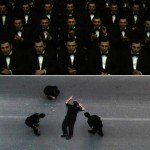Goran Skofic
dal 17/2/2009 al 21/2/2009
Segnalato da
17/2/2009
Goran Skofic
Galerija Karas, Zagreb
The central preoccupation of the most recent video installation by artist titled 'Corpus' is the impossibility of reaching life's immediacy deprived of everyday spectacle and numerous social imperatives. The author records how a body is overstretched with a desire to break 'the world speed record', so it is increased tenfold in order to succeed. Recognizable speeds have become insufficient so the body has to break all the limits in order to achieve a desired goal.

Fitter, happier, more productive, comfortable, not drinking too much,
regular exercise at the gym, 3 days a week, getting on better with your associate employee contemporaries, at ease, eating well, no more microwave dinners and saturated fats, a patient better driver, a safer car, baby smiling in back seat, sleeping well, no bad dreams, no paranoia…
Radiohead, Fitter, happier
Around the middle of the past century a claim by Guy Debord was valid: all life is revealed as an incommensurable accumulation of spectacle. Everything that was directly happening was transposed into representation, claimed Debord in his book “Society of the Spectacle”. However, today we live in the third stage of simulacrum, as argued by Baudrillard, the stage of complete simulation which replaces representation. Presently, thanks to media-mediated reality, the time needed to elapse from an actual event to its spectacular representation has disappeared. Truly, the spectacle is happening here and now, live, within our lives.
It seems as if impossibility of reaching life’s immediacy deprived of everyday spectacle and numerous social imperatives is the central preoccupation of the most recent video installation by Goran Škofić, titled “Corpus”. The author records how “a body is overstretched with a desire to break ‘the world speed record’, so it is increased tenfold in order to succeed. Recognizable speeds have become insufficient so the body has to break all the limits in order to achieve a desired goal.” Therefore Škofić, with a noticeable dose of irony and subversive humorous elements, uses ten short video recordings to present the body which no more knows a stage of repose. The body, in this case the artist’s (yet, Goran Škofić adds, “it could be yours as well”) becomes an object of manipulation through using the video image and editing procedures. The body becomes accelerated, simultaneous and manifold in scenes that appear at ten video screens. Walking through the installation, a visitor passes through various situations the body is subjected to, asking: Which body is the real one? The answer is very simple. The real body has disappeared since it has became insufficient. Our culture turned schizophrenic in a manner of consumers’ ecstasy. We enjoy imaginary visions and images of media-created collective fantasy in which the time has become the most sough-after commodity. The body cannot act by itself, for itself and therefore it becomes simulated – recorded, directed, edited and projected.
I believe the author, within the everyday spectacle of consumption, represents the body as superfluous, incomplete and unreliable. The real body is a looser. However, Škofić comes to the aid of his body with the electronic images. Pixels transform the body into a corpus – a non-identity entity, a junction of technology and absurd. Ultimately, technology has been created in order to annul a horrifying truth about body’s insufficiency. J.G. Ballard has argued that science fiction “is a body’s dream of becoming a machine”. This dream became reality in numerous sci-fi films like Terminator, Robocop or Exterminator. All these machines i.e. androids are perfectly precise and lethal, their bodies are “sufficient”, yet they possess an autonomy of will and an identity, the dreams of their own. Škofić, on the other hand, presents corpus/es – the prisoners of Baudrillard’s media hall of mirrors in which reality is devoured by the infinite number of reflections.
Therefore Škofić’s body turns into Corpus that becomes sufficient only when multiplied and simultaneous. Only in this way the corpus can reach its goal, only by “realizing” there is no goal. All the manners of interpreting a meaningful goal have gone to hell long ago. The meaning has disappeared in the chasms of incessant production and consumption. It is why Goran Škofić provides none of his “Corpuses” with a meaningful ending; a football fan is sentenced to an eternal football match, a theatre encore demands an endless applause, a runner is constantly competing himself, shooting out a penalty goes on forever…. Corpus/es are electronic reproductions, irretrievably lost to their own original or meaning, and long ago defeated in a battle for credibility. Moreover, a multiplied corpus that was recorded in a theatre, along with its uniformity and calmness of facial mimics, irresistibly recalls Agent Smith, the antagonist of cult movie Matrix. Therefore it seems to me as if the artist, like Morpehus, a character from the mentioned movie, sends a following message: “Welcome to the desert of the real”. He also asks how many phantom corpuses will suffice.
Of course, a meaningful complex, a utopian solution, is not impossible. Though I notice how the agony of the corpus does not find its abolition in a final performance of the action assigned. Namely, a video recording – just as the corpus’ situations – does not have beginning nor the end – a loop has prevented the covering of Baudrillard’s mirrors and abolished a potential meaning. The corpus, same as the body, is sentenced to the eternal repetition of the same, the Sisyphean curse in the desert of the real. (Leila Topić )
Opening on wednesday, February 18th 2009, at 8 pm
Galerija Karas
Praska 4, Zagabria



